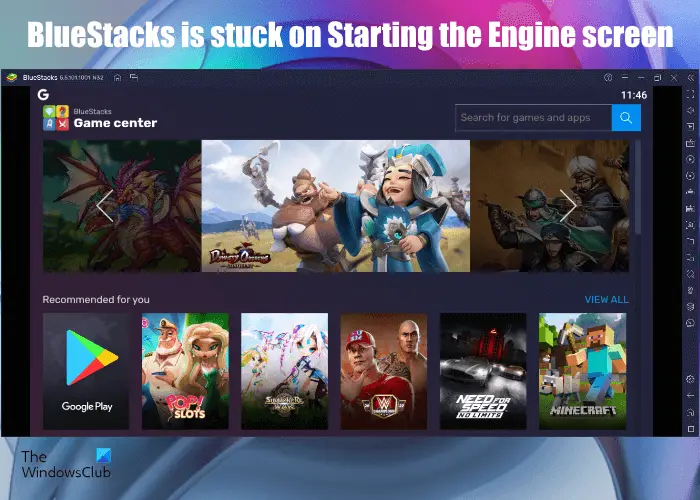In order to run a particular software on your Windows computer, it should fulfill all the hardware requirements. You will also experience this problem if your system is not compatible with BlueStacks. Therefore, before you install BlueStacks on your system, it will be better if you check the hardware requirements for BlueStacks from the official website.
BlueStacks is stuck on Starting the Engine screen
If BlueStacks gets stuck on Starting the Engine screen and is not proceeding further, you can try the solutions explained in this article to get the issue resolved. Before you proceed, we suggest you try the following quick fixes and see if they help:
Restart your computer.Kill unwanted background processes and applications to free up some RAM.Check if your system is running on the latest version of Windows 11/10. If not, install the latest Windows 11/10 updates.Repair the corrupt system files by running the SFC and DISM scans.
If after trying the above quick fixes, you still experience the same issue again, you can proceed towards the troubleshooting methods described below. Let’s see all these solutions in detail.
1] Enable Virtualization
To use BlueStacks, your Windows computer should support the Virtualization technology. If your computer supports Virtualization, you have to enable it. Computers of different brands have different methods to enable Virtualization. After enabling Virtualization, launch BlueStacks and check if it gets stuck on Starting the Engine screen this time or not.
2] Allocate more CPU cores and RAM to BlueStacks
If your system supports Virtualization and despite enabling Virtualization, you are still experiencing the same issue with BlueStacks, allocating more CPU cores and RAM to BlueStacks may fix the problem.
The following steps will guide you on how to allocate more CPU cores and memory to BlueStacks: Allocating the higher CPU cores and memory to BlueStacks will boost the performance of apps and games running inside BlueStacks. But this will also increase pressure on your CPU and RAM. This may affect the performance of the laptops with low configurations, say 4 CPU cores and 4 GB RAM. In this case, if you run another application in parallel to BlueStacks, your system may hang or freeze. On the other hand, increasing the number of CPU cores and RAM for BlueStacks will not affect the laptops with a good configuration, say the laptops with 8 or more CPU cores and 8 GB or more RAM. Do not allocate all the CPU cores and entire memory to BlueStacks. While increasing the CPU cores and RAM for a particular app, always select a value lower than the total number of CPU cores and RAM your system has.
3] Disable your antivirus temporarily
Your antivirus might be interrupting the working of BlueStacks. To check this, first, disable your antivirus software temporarily and then launch BlueStacks. If BlueStacks does not get stuck on Starting the Engine screen, your antivirus is preventing BlueStacks from working properly. In this case, you can disable your antivirus while using BlueStacks and enable it again after exiting BlueStacks.
4] Update your graphics card driver
You may also experience this issue with BlueStacks if your graphics card driver is not up to date or corrupted. In such a case, updating the graphics card driver fixes the problem. When it comes to updating the graphics card driver, Windows 11/10 users have the following options: This should fix the problem.
How do I fix BlueStacks stuck on startup?
The problem of BlueStacks getting stuck on startup or on initializing screen might be occurring due to a minor bug in the software. In such a case, uninstalling and reinstalling the latest version of BlueStacks may fix the problem. Apart from that, you can also try running BlueStacks in compatibility mode and checking its administrative privileges.
Why is BlueStacks not working on Windows 11/10?
If BlueStacks is not working on your Windows 11/10 system, first, you should check whether or not your computer fulfills the minimum hardware requirements for BlueStacks. If despite having the compatible hardware, BlueStacks does not work on your system, you can try a few more things, like enabling the Virtualization, updating your graphics card driver, etc. If nothing helps, uninstall and reinstall BlueStacks after downloading the latest version from its official website. If BlueStacks is not starting when Hyper-V is enabled, you should check and configure the settings of Hyper-V. Hope this helps.

